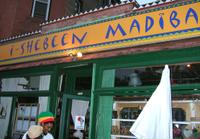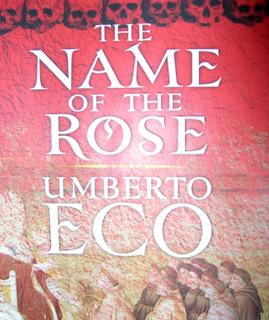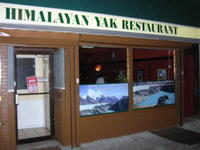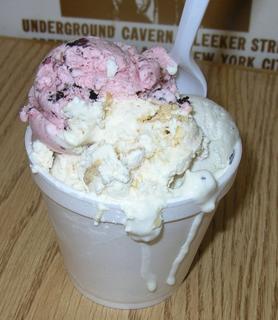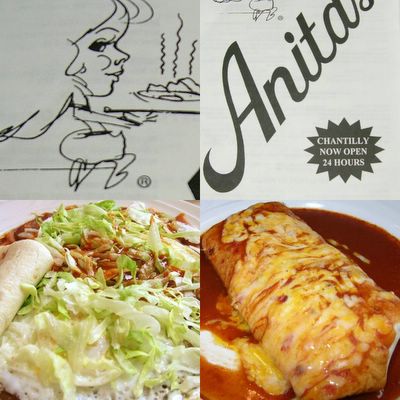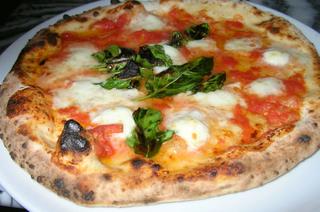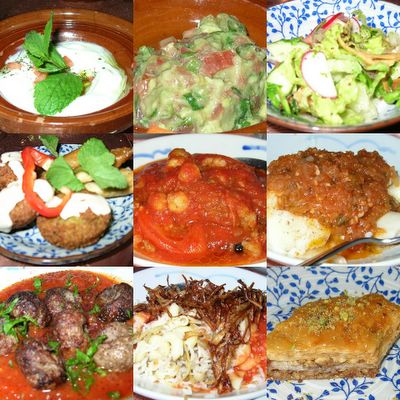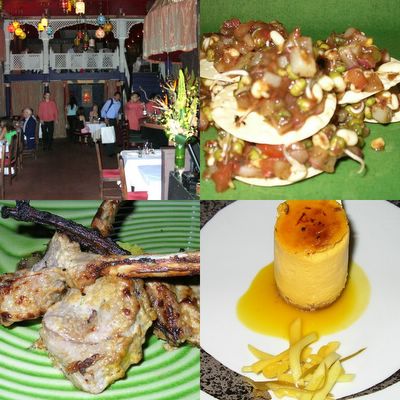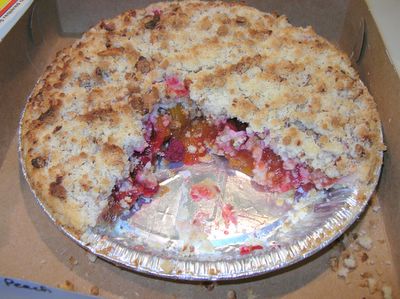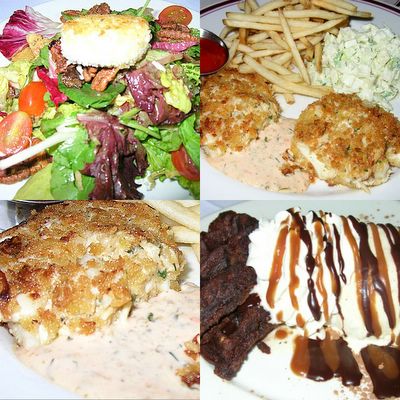 RESTAURANT: Cacio e Pepe
RESTAURANT: Cacio e PepeLOCATION: 182 Second Avenue
DATE: July 8, 2005
FOOD: Tonnarelli cacio e pepe (Traditionally prepared homemade pasta tossed with pecorino romano cheese and black pepper); Split the following: Gnocchi di ortica con pomodori confit, rosmarino e mozzarella di bufala (Homemade nettle gnocchi tossed with tomato confit, rosemary and buffalo mozzarella); Saltimbocca di coda di rospo (Monkfish layered with prosciutto Parma and sage leaves sautéed in butter and white wine).
BEVERAGE: Glass of White Wine
PRICE: $45.00
As the old saying goes, when in Rome…
At last check, www.citysearch.com had 1084 Italian restaurants listed in Manhattan alone. In such a crowded marketplace, how does one Italian restaurant stand out among the rest? Simple. By serving exceptional, mind-blowing, jaw-dropping, earth-shaking, preconception shattering food that transports you on some supersonic Vespa to the hills of Tuscany and the crowded streets of Rome. That’s how. Cacio e Pepe, located in the East Village, succeeds at serving just this type of food, distinguishing itself amongst the rest of New York’s Italian eateries.
Firstly, there’s the cozy confines. Dark wood tables adorned unpretentiously with candles and emerald olive oil, greet customers, and offer a perfect setting for a romantic rendezvous. The wait staff is knowledgeable and engaging, ready to supply a recommendation or meet any request. Throughout the meal, the owner and chef wander from table to table, stopping for conversations with regular and first-time diners alike. This personalization only enhances the effect of the food, creating a complete dining experience. The concise and reasonable wine list provides a sample of the wine Italy is known for. Courses are well spaced, the presentation refreshingly simple – the kitchen operates with an efficiency even the railroads during the Mussolini reign couldn’t emulate.
But secondly, and most importantly, there’s the pasta. Pasta might have been a Chinese invention, exported by Marco Polo, but the Italians deserve the credit for perfecting this worldwide favorite. Cacio’s pasta only augments this tradition. The essential pasta is the very dish from which the restaurant takes its name – Cacio e Pepe. It’s deceptively uncomplicated mix of ingredients hides a myriad layering of flavors. The dish begins when a waiter brings the steaming pasta tableside in the hollow of a huge wheel of pecorino cheese. Expectation mounts as he scoops the cheesy spaghetti like noodles from the concavity, halved peppercorns, a touch of olive oil, and flakes of fresh Italian parsley the only other accoutrements to this pasta. Once the server plates the pasta, he then scrapes the partially melted sides of the pecorino wheel, topping the pasta with spoon after spoon of liquefying cheese crumbles. As Frank Bruni’s New York Times reviews remind us however, ornamentation means nothing if it lacks substance. Fortunately, the effort involved in preparing the Cacio e Pepe is outdone by the sublimity of its taste. Like a silk sleeve, the cheese coats the noodles. The sharpness of the pepper and robust saltiness of the oil makes the Cacio e Pepe truly extraordinary, the type of meal that redefined my opinion of pasta. In four visits to Cacio, I’ve had the Cacio e Pepe three times (it was not offered on the fixed New Years Eve menu) and if possible, it somehow gets better each time. The overcooked lamentations of pastas past are lost in the utopian smoothness of this dish.
But unlike Giuseppe di Lampedusa, author of The Leopard, Cacio e Pepe’s pasta menu is able to produce more than one great hit. The gnocchi, flavored with the same stinging nettles used to treat medical ailments ranging from insect bites to inflamed joints, team with rosemary to create an absolutely astonishing version of this potato based course. My friend Will, having made gnoc
 chi countless times with his mother, was still taken back at the softness Cacio’s gnocchi achieved. The buffalo mozzarella and fresh tomatoes that garnish the gnocchi contribute a caprese feel to the dish which fits sublimely. The manager informed us that the nettles boil for hours until they reach a stage where they go from obnoxious skin irritants to delicious gnocchi infusion. However long they take, it’s worth it. Again, Cacio uses only a few ingredients to create a magnitude of taste.
chi countless times with his mother, was still taken back at the softness Cacio’s gnocchi achieved. The buffalo mozzarella and fresh tomatoes that garnish the gnocchi contribute a caprese feel to the dish which fits sublimely. The manager informed us that the nettles boil for hours until they reach a stage where they go from obnoxious skin irritants to delicious gnocchi infusion. However long they take, it’s worth it. Again, Cacio uses only a few ingredients to create a magnitude of taste.Thirdly, there’s the entrees. Saltimbocca usually consists of grilled pork fillets topped with crisp prosciutto. But Cacio e Pepe re-imagines this classic dish, using the meaty flesh of monkfish in
 place of the pork. Oh, if only all such remakes could be so skillful. Seldom, if ever, does one see a chef with the ability and courage to use fish as a thin cutlet, given its propensity to flake and dry-out. But Salvatore Corea is that brave. The monkfish is as succulent as roast chicken, somehow able to be both satisfying dense and weightless at the same time. The crisp prosciutto provides an ideal level of saltiness, merging effortlessly with the light butter, sage, and white wine saucing. Cacio’s saltimbocca is one of those rare dishes that appeals in any type of weather, rewarding for the heartiest of winter’s demands, or the breeziest of summer nights. Robert More might have termed Sir Thomas More the Man For All Season in his play, but Cacio’s saltimbocca is the right entrée for any time of the year.
place of the pork. Oh, if only all such remakes could be so skillful. Seldom, if ever, does one see a chef with the ability and courage to use fish as a thin cutlet, given its propensity to flake and dry-out. But Salvatore Corea is that brave. The monkfish is as succulent as roast chicken, somehow able to be both satisfying dense and weightless at the same time. The crisp prosciutto provides an ideal level of saltiness, merging effortlessly with the light butter, sage, and white wine saucing. Cacio’s saltimbocca is one of those rare dishes that appeals in any type of weather, rewarding for the heartiest of winter’s demands, or the breeziest of summer nights. Robert More might have termed Sir Thomas More the Man For All Season in his play, but Cacio’s saltimbocca is the right entrée for any time of the year.Finally, there are the innovative desserts, which I’ve had before but was too full to nibble on this time. But with offerings like green tomato strudel and cantaloupe mousse, I have plenty of reason to go back.
When I first visited last September, Cacio e Pepe reaffirmed my belief and love of Italian food after years of palate numbing meals at the Olive Garden and Rigazzi’s. Three visits, one surreally romantic New Year’s Eve, and countless noodles later, Cacio e Pepe continues to enchant and amaze me. After spending a night in the mystical candle lit interior, fortifying oneself on phenomenally redolent and near perfect cuisine, one might almost wonder whether the Roman Empire, with the ability to produce such sensational food, really declined and fell centuries ago, or if it’s just a lie Edward Gibbons used to sell his history books. Regardless, we should all go to Cacio and do as the Romans.
RATING: 9.4/10
